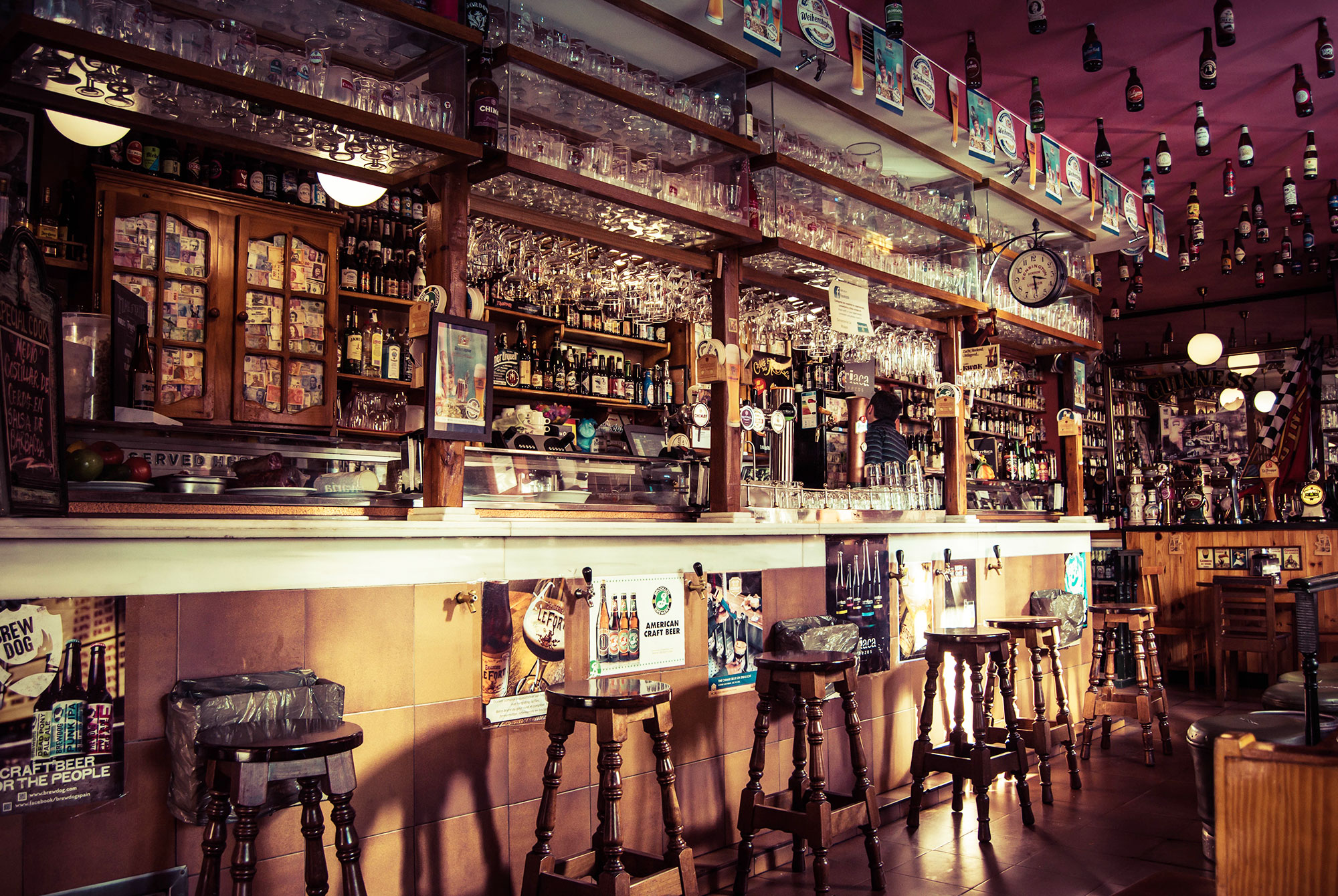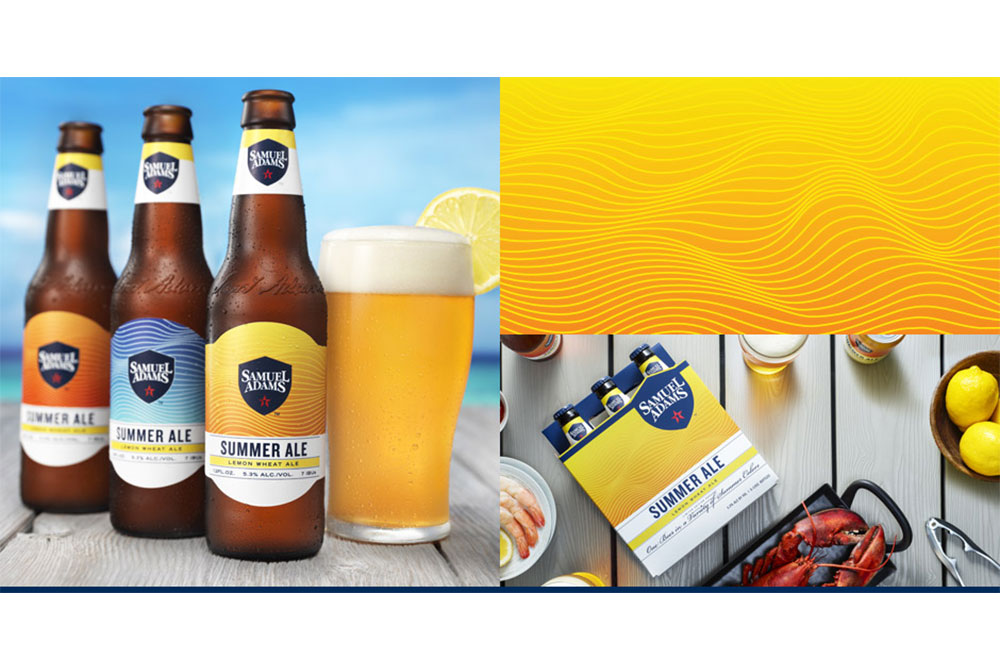Shop
How the Best Bars Curate Their Craft Beer Menu
Lessons from the field.
This article was originally published by our friends at BeerMenus, who — in addition to helping drinkers find craft beer — also run a blog.
It’s a good time to be a beer lover. There are now more than 5,000 breweries in the United States alone—that’s twice as many as there were just four years ago.
But there’s another trend—a more subtle change—that’s influencing the way restaurants, bars and taprooms sell beer. Brewers Association economist Bart Watson calls it “premiumization.”
Beer lovers are consuming more high-end beer. They’re willing to pay for brand, location, and taste. They’re expecting an experience. This puts the onus on beer sellers to curate interesting and diverse tap lists. That process is both art and science—equal parts taste and data.
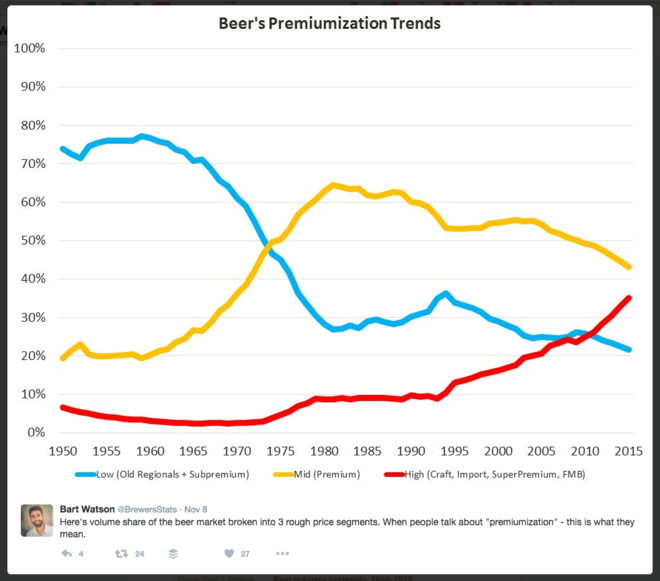
According to our co-founder and resident Level 2 Cicerone, Will, a tap list curator has two primary responsibilities:
- Reflect the tastes of your neighborhood. If your customers can’t get enough Dubbels, by all means, keep them coming.
- Tell a story with beer. Introduce new beers, explain why you’ve chosen them, and keep people excited to come in the door.
Understand the numbers behind the tap:
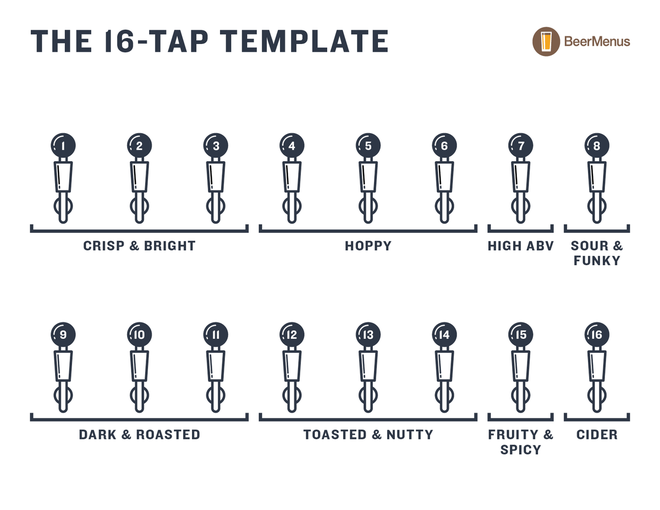
The tap list affects how often people come, how long they stay and how much they enjoy spending time at your bar or restaurant as opposed to others nearby.
Above all else, have integrity over your list. Cutting deals with distributors to guarantee the big brewers tap lines is a disservice to your customers. Keeping the same old beers on tap out of habit will bore people. More than anything else, your job is to maximize happiness—people love beer and you have the chance to make their experience a great one.
Regardless of which beers you choose to sell, we’ve provided below a basic template to help you make sure you’ve got something for everyone.
Within each of these categories, there are hundreds of great beer options and plenty of ways to make sure you’re serving up the brews people want.
It’s easy for the beer lovers behind the bar to forget that limited release bourbon barrel-aged imperial stouts aren’t for everyone. Even if your ideal customer is a sophisticated drinker, a diverse list is good for business. People like to drink and eat with their friends—serving beers that are accessible and interesting to a wide variety of people will keep your bar or restaurant busier than a narrow list of high end (or low end) beers.
Pick the right flavor profiles:
The word “flavor” is the tip of a very deep iceberg. As Will often reminds us, “Beer is one of the most varied beverage categories. You can make beer with just about anything.”
Perhaps some brewers have taken this too literally—the folks at Mikkeller made an oatmeal stout with rare Kopi Luwak coffee (which is produced only after being consumed and passed by the Civet)—but that’s what’s so great about this industry. Brewers are an adventurous bunch.
There are near-infinite factors that affect the way humans interpret the way something tastes. But, to keep it simple, you need to know that there are five independent flavors that humans taste:
- Sweet – usually the result of sugar or fructose
- Salty – think potato chips
- Sour – from acid
- Bitter – coffee, hops, goodness (also: cat feces)
- Umami – aka savory foods like meat and fish
Simple enough, but beer has one other factor to take into consideration besides experience. Cicerone Certification Program founder Ray Daniels says that flavor = taste + aroma. The way something smells is inextricably linked to the way it tastes in our mouths.
Every combination of flavor profiles and aromas come together to make these flavors in different proportions. In practice, you need beers that appeal to each of these different flavor profiles, though you’ll rarely communicate about food or beer with words like “umami.” The template above translates this language into layman’s terms.
Determine your beer’s accessibility:
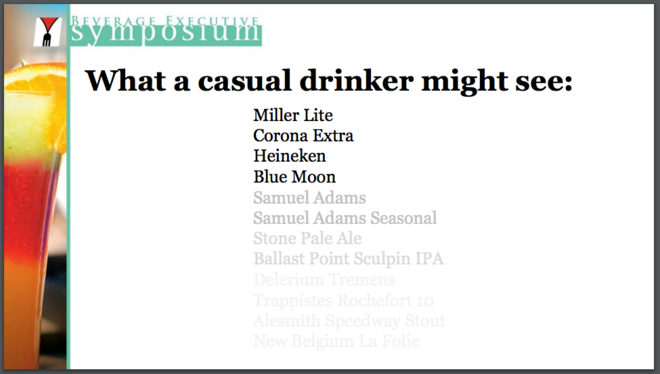
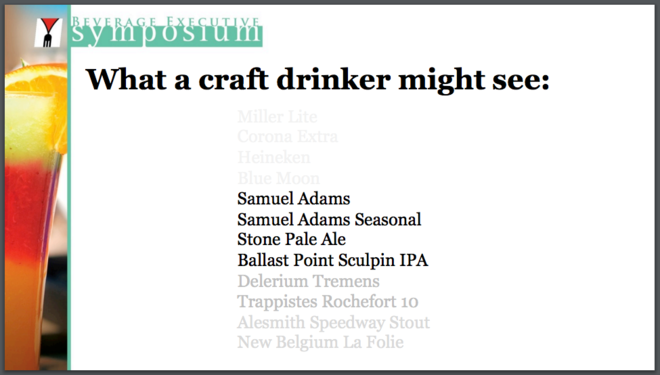
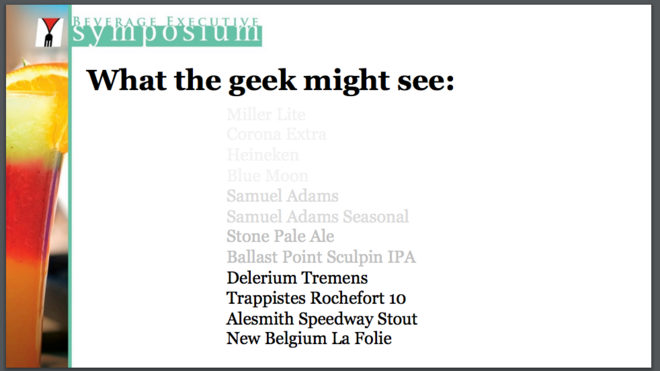
Beer drinkers exist on a spectrum ranging from casual drinkers to craft enthusiasts. A balanced tap list should reflect that. If 14 of your 16 taps are local, exclusive beers, you’ll appeal to just one end of that spectrum. If eight of your 16 taps are light, mass produced lagers, you’ll only appeal to the other end. Striking a balance is key for nearly every bar or restaurant, even those that cater to one end of the spectrum.
And here’s why: a great experience with the first beer is more likely to result in a second beer. Consider a tap room that caters primarily to folks who enjoy premium, high-end IPAs. You might need a Blue Moon or a common cider on your list so that if they bring a non-beer-loving friend, that person can have a great experience too. Casual drinkers are less likely to be adventurous with their beer selection, so familiar brands and lighter tastes can serve as “gateway” beers. That means you need a variety of beers on your draft list – i.e., a broad spectrum ranging from Miller Lite to Delerium Tremens.
You should also assume that your list should at least touch on styles that appeal to a wide range of people. Stuart Melia, Vice President of Beverage at Rock Bottom, keeps some of each of the following styles on his tap lists at all times:
- Light / Kolsch, Blonde Ale, Light Lager
- Malty / Red Ale, Irish Red
- Hoppy / Pale Ale, IPA
- Dark / Stout, Porter, Black Lager
- IBU + / Double IPA, Anything over 55 IBUs
- High ABV / Anything over 7.9% ABV
Selling beer to people who love beer is easy. But you’ll also want to account for “cross drinkers,” people that also enjoy wine and cocktails. This group might enjoy a sour beer, a cider, a spirit-barrel-aged beer, or even a hard soda.
Envision your food pairings as the diner:
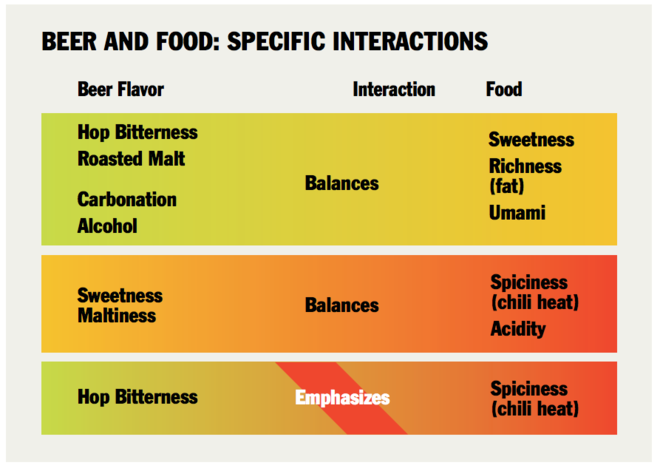
The style of food you serve obviously affects the beers you’ll keep on tap. Food and beer go well together, but there are a few simple rules that can make pairing them easier. There are two basic approaches to pairing food and beer.
Match complementary flavors: You can pair beer with a food that matches its flavor profile. The roasted, malty taste of a good stout, for example, pairs nicely with desserts. It could even be one. A hoppy, fruity IPA will perfectly complement salmon topped with fresh-squeezed lemon. You can look to opposite ends of the flavor spectrum to find good pairings as well. IPAs, for example, can balance out spicy chicken curry.
As you get more sophisticated, you can “cut” certain flavors with carbonation and ABV, or even create brand new flavors. The Brewers Association maintains a detailed list of beer and food pairing suggestions, but here are a few simple guidelines:
- American Pale Ales go great with burger
- IPAs pair nicely with spicy foods
- Stouts complement chocolate and other deserts
- Hefeweizens and pilsners do well with lighter fare like salads and sushi
- Ambers and red ales are flexible
If your customers are sitting down to eat, it’s likely they’ll have more than one drink. Their choices will reflect the trajectory of their evening. They may, for example, start off with a new beer they’ve never tried, then transition into a lighter beer while they eat before finishing the night with a high ABV nightcap. A great beer list not only appeals to a wide spectrum of people and pairs nicely with food, it takes into account the different jobs the beer is being hired to do.
Specialty joints like seafood and BBQ restaurants will need to customize their tap list for food pairings more than a burger bar does. Same goes for Irish pubs, who might lean heavily on Guinness and Smithwicks, or German beer halls who could swap out an Amber for a second Hefeweizen.
The seasons will affect your food and beer menu, too. Winter in Chicago calls for a strong stout paired with sliders. Summer in Austin, a double IPA with brisket. There are few binding rules when it comes to beer and food pairings. It’s always a good idea to test new pairings and get feedback from customers.
Some more, more obvious, practices
Here’s a list you can use alongside the template to make decisions about a balanced tap list. Do you have…?
- A wide range of flavor profiles
- Accessible beers for “cross drinkers”
- Exclusive beers for craft lovers
- Great seasonal beers
- Beers that pair with the food menu
- A few constants to keep regulars happy
- A few trendy beers
- Beers that are proven sellers
There are a few other ways to inform your list. They may not get the elaborate explanation, or even make the list, but that doesn’t mean they’re any less important. It’ll be the little things that sets your list apart from the others:
- Ask your customers which beers they’d love to see on tap.
- Keep an eye on beer rating sites like Beer Advocate and Rate Beer to bring in fan favorites.
- Have a regular dialogue with your distributor and check sites like Beer Pulse to know what’s hot right now.
- Monitor sales on every beer you sell. Price point and demand are two key data points to inform future beers.
You don’t need to be a Master Cicerone to put together a great tap list, but you do need to understand how to keep the hopheads excited while appealing to folks who typically opt for wine or a cocktail – or, a Miller Lite. There are beer flavors out there for everyone, it’s just a matter of sourcing a diverse menu for anyone who might walk into your bar.

